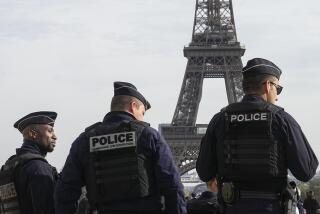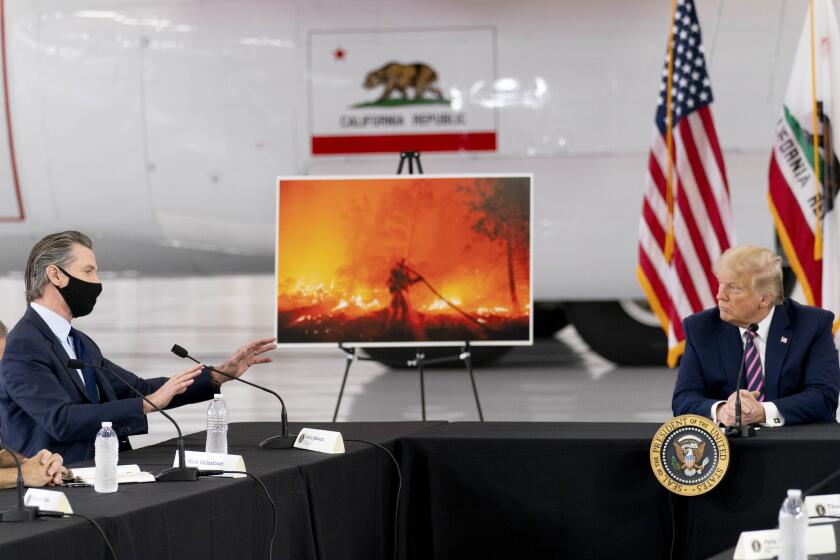Journalists Divided on LAPD Plan for Media Helicopter
A proposal by the Los Angeles Police Department to take charge of a media helicopter for shooting videotape of protests and other events downtown during the Democratic National Convention is raising questions of press independence and police tactics.
Some fear it will make local television a branch of the LAPD. Others say it is the only way to provide vital images to the public.
This debate among local newscasters brewed this week as they mulled over the LAPD offer to provide exclusive footage from the no-fly zone during the convention.
The proposal was pitched to Radio and Television News Assn. members at a meeting in Los Angeles last Friday, after a surveillance helicopter used by the department broke down, according to sources familiar with the proposal.
If approved, a helicopter leased by KMEX-TV Channel 34 would be allowed to enter a 1.5-square-mile no-fly zone above Staples Center, but only under the control of police, who would also determine what will be videotaped, said news executives who attended the meeting. In addition, the broadcasters would pay a fee to cover fuel costs, as the helicopter is expected to fly long hours each day of the convention. Images from a regular LAPD helicopter would also be available to the broadcasters, those attending the meeting said.
A KMEX spokeswoman declined to discuss the proposal, referring questions to Radio and Television News Assn. officials. Only one could be reached and she declined to discuss the matter while the vote was still pending. LAPD spokesman Lt. Horace Frank also would not discuss the proposal because it wasn’t finalized.
Police officials assured members at the Friday meeting that they would not censor the video or turn off the cameras, even if the images portray police in a bad light, association members who attended the meeting said.
As a result, KTLA-TV Channel 5 News Director Jeff Wald said Thursday that his station was casting its vote to accept the deal.
“We don’t have much choice,” Wald said. “That’s the heart of the city. If anything happens, there is no way for us to get pictures unless we are lucky enough to have a camera at the right place.”
The Los Angeles Times, owned by Tribune Co. which also is the parent of KTLA, has no plans to take part in this or any similar arrangement, Executive Editor Leo Wolinsky said. “Our job is to bring news to the people and we want to do that ourselves,” he said.
“What we don’t want to do is publish photos that, in effect, have been censored by police,” Wolinsky said.
Other news organizations, like “CBS Evening News,” decided it would be inappropriate to go along with the proposal.
CBS will somehow manage without aerial footage, said Los Angeles Bureau Chief Jennifer Siebens. She added that she was surprised the proposal came up. “We felt it crossed a line where news media would be serving law enforcement,” Siebens said.
That sentiment was echoed by Jane Kirtley, Silha professor of media ethics and law at the University of Minnesota.
“This is a deal with the devil as sure as anything,” she said. “Do news organizations want to put themselves into a position of being the surveillance arm for law enforcement?”
Not that attempts to control the media are anything new, she added. During the Gulf War, journalists had to submit their work for prior review by military officials. To make matters worse, not all news organizations consistently notified the public that their reports or images were being handled by the military, she added.
Wald said his station would be informing the public that the aerial shots are “pool photos.”
“As long as these pictures are dispassionate, [filmed] flying over an area we otherwise have no access to, it’s a reasonable way for us to achieve our goals to have pictures for public.”
Still, blurring the lines between law enforcement and the media is “not healthy,” said Peter Dreier, professor of public policy at Occidental College. “The public should be confident that the media’s view of the events at the Democratic National Convention and its surroundings is independent of the Police Department’s view.”
The LAPD arrangement will further erode public trust in the media, said Lisa Fithian of the Direct Action Network, which is helping coordinate protests aimed at the convention. “Why do they have to control the coverage and use the media as a disguise?”
She and Ramona Ripston, executive director of the American Civil Liberties Union of Southern California, also questioned the need for a large no-fly zone. “It is important for the press to be able to film whatever is happening at Staples Center,” Ripston said.
More to Read
Get the L.A. Times Politics newsletter
Deeply reported insights into legislation, politics and policy from Sacramento, Washington and beyond. In your inbox three times per week.
You may occasionally receive promotional content from the Los Angeles Times.










